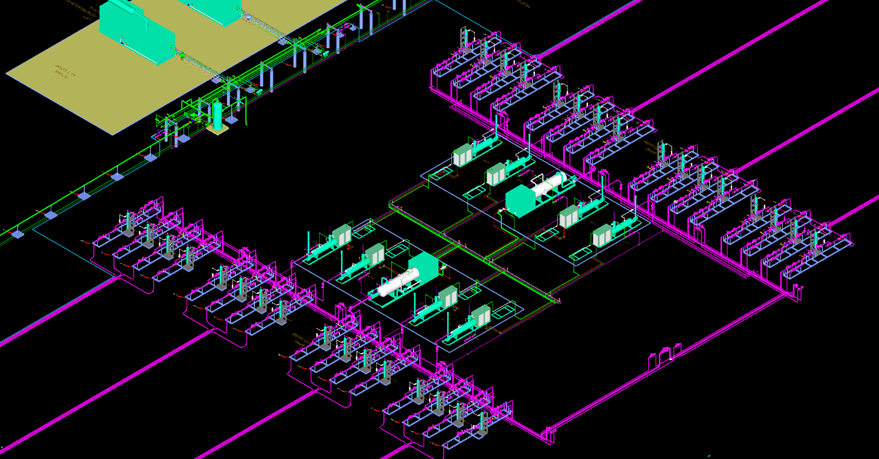Benefits of The Tankless Production Facility
Posted on January 7th, 2022
Posted in Uncategorized

In a prior article, The Tankless Production Facility: Thrills and Chills, we briefly introduced the concept of tankless facilities with an overview of reasons for and against adoption of the tankless facility. As ever, regulatory scrutiny is kindling further interest in tankless facilities. In this entry of The Tankless Production Facility series, we’ll go into more detail as to the benefits of tankless production facilities.
Safety
Potentially one of the most overlooked benefits of tankless facilities is the elimination of significant safety hazards. Atmospheric storage tanks are almost always equipped with PVRVs and/or thief hatches which allow air ingress into the tanks or tank vapor egress from the tanks. These devices are required to keep the tanks operating within their design pressure / vacuum but are the source of explosive atmosphere hazards and toxic atmosphere hazards under normal conditions. Some well-known tank safety hazards, causes, and solutions are listed in the table below.
| Hazard | Cause | Solution |
| Fire / Explosion | Ignition source introduction by public | Administrative Controls – signage, gates, education of public regarding hazards |
| Fire / Explosion | Ignition source introduction by workers | Administrative Controls – employee education and training regarding hot work and hazards |
| Fire / Explosion | Ignition source introduction by lightning / static charge | Engineered Controls – lightning protection and grounding system |
| Toxic poisoning / suffocation | Release of H2S/LEL gas through a thief hatch while an operator is present at the top of tanks | Administrative Controls – restrict access to tops of tanks using signage
Personal Protective Equipment –require use of 4-gas monitors and optionally provide supplied air for tank top access |
Despite how well-known these hazards are to industry, actual incidents happen with startling frequency. The United States Chemical Safety Board (CSB) discovered a staggering 26 tank explosion incidents in the 28-year period spanning 1983 to 2010 attributable to an ignition source being introduced by the public; in total 44 deaths and 25 injuries were identified in the study [1]. This study does not indicate frequency or severity of incidents related to the other three causes.
A facility design with atmospheric tanks has a known toxic or explosive atmosphere hazard under normal conditions, for which safeguards are implemented. Yet loss-of-life incidents still happen with too much frequency because the safeguards fail for one reason or another. Shifting to a tankless facility design without atmospheric storage tanks eliminates the toxic or explosive atmosphere hazard altogether.
Economics
Although the per tank capital cost for atmospheric storage tanks doesn’t stand out on its own, the total installed cost of a tank battery can be significant. A typical battery of (8) 400-bbl tanks can cost more than $300k when accounting for each tank itself, its foundation pad, crane costs, pipefitting, piping, and welding, PVRVs and instrumentation, and containment liner with diking.
To operate a tankless facility, existing equipment such as vapor recovery towers or heater treaters may need to be upsized to boost surge volumes for the pipeline pumps, but this cost is anticipated to be equal to or less than the savings from eliminating the atmospheric storage tanks.
Additional economic benefits can include: increased recovery of product gas that would otherwise be disposed of in the tank vent flare system; facility footprint reductions; elimination of trucking; reduction in permitting costs; and reduction in operating costs associated with emissions reporting.
Emissions
Reduction in emissions, especially methane emissions, associated with leaking thief hatches or PVRVs is likely the primary draw of tankless facilities for many readers. As regulations tighten to reduce allowable emissions, increase the cost to emit, or specify more stringent performance standards, there is a significantly increased interest in facilities without atmospheric storage tanks. For facilities that fall under OOOOa and exceed the potential to emit (PTE) 6 tons/year VOC threshold, a tankless design removes the storage vessel reporting requirements which, in turn, reduces the operational expenses associated with reporting, testing, and repairs. While safety and economics are optional drivers to develop tankless production facilities, tightening emissions regulations will likely drive tankless designs to be an eventual requirement.
Conclusion
It is thought that for safety, economic, and emissions-related reasons tankless production facilities are the future. Yet for all the benefits of not having atmospheric storage tanks, they have been a staple of well pad production facility design for many years for good reasons. In a future article, we’ll explore the challenges associated with not having atmospheric storage tanks and some potential solutions.
Sources
[1] U.S. Chemical Safety and Hazard Investigation Board, “Investigative Study: Public Safety at Oil and Gas Storage Facilities.” Rep. 2011-H-1, September 2011. [Online]. Available: https://www.csb.gov/oil-site-safety/
 Curtis Anderson is a seasoned Projects Director at Halker, specializing in managing projects for electric utilities and renewable energy companies, including high voltage power, solar, wind, and battery energy storage systems (BESS). Prior to his current role, Curtis held various leadership positions with 12 years in the industry. As Technology Innovation Manager, he was instrumental in establishing and leading a Product and Innovation team within the Power and Renewables Industry, driving technology enablement initiatives, and fostering a culture of innovation. His work included guiding the development of new products, implementing AI-driven solutions, and supporting the launch of industry-first SaaS offerings. Curtis also played a key role in business-to-business collaborations, strategic planning, and served as a member of an Artificial Intelligence Governance Board, focusing on enhancing operational efficiency through technology and R&D efforts.
Curtis Anderson is a seasoned Projects Director at Halker, specializing in managing projects for electric utilities and renewable energy companies, including high voltage power, solar, wind, and battery energy storage systems (BESS). Prior to his current role, Curtis held various leadership positions with 12 years in the industry. As Technology Innovation Manager, he was instrumental in establishing and leading a Product and Innovation team within the Power and Renewables Industry, driving technology enablement initiatives, and fostering a culture of innovation. His work included guiding the development of new products, implementing AI-driven solutions, and supporting the launch of industry-first SaaS offerings. Curtis also played a key role in business-to-business collaborations, strategic planning, and served as a member of an Artificial Intelligence Governance Board, focusing on enhancing operational efficiency through technology and R&D efforts. Shannon McKibben is the director of Environmental Engineering at Halker, executing environmental, health, and safety projects for clients in construction, oil & gas, transportation, and power delivery. Under Shannon’s leadership, Halker’s Environmental Engineering group is actively diversifying from its historical role serving primarily road and highway construction clients into a support group for all of Halker’s projects, focusing on energy delivery and development.
Shannon McKibben is the director of Environmental Engineering at Halker, executing environmental, health, and safety projects for clients in construction, oil & gas, transportation, and power delivery. Under Shannon’s leadership, Halker’s Environmental Engineering group is actively diversifying from its historical role serving primarily road and highway construction clients into a support group for all of Halker’s projects, focusing on energy delivery and development. Dominic brings over 15 years of leadership in privately held and PE‑backed firms. Dominic’s experience in the energy industry expands across several sectors, including refining, midstream & pipeline and delivering fully modular facility solutions in the upstream production arena. Dominic has been involved in the sales and project management of more than 30 fully modular facilities in the Permian basin. He has built scalable go‑to‑market strategies that have helped drive impressive revenue growth: from $10M to $25M at Welker, and launching Petrosmith’s Modflex line to $40M in three years, while more than doubling revenue with its largest client.
Dominic brings over 15 years of leadership in privately held and PE‑backed firms. Dominic’s experience in the energy industry expands across several sectors, including refining, midstream & pipeline and delivering fully modular facility solutions in the upstream production arena. Dominic has been involved in the sales and project management of more than 30 fully modular facilities in the Permian basin. He has built scalable go‑to‑market strategies that have helped drive impressive revenue growth: from $10M to $25M at Welker, and launching Petrosmith’s Modflex line to $40M in three years, while more than doubling revenue with its largest client. 




 Philip Barr joined Halker in April 2023. With nearly 20 years of structural engineering experience, he has contributed to projects across the oil and gas, pharmaceutical, chemical, mining and metals, and manufacturing industries. Philip has successfully led structural design teams in executing projects totaling over one billion dollars in value. He has also worked internationally as a field engineer and client representative, gaining valuable experience in constructability, modular design, and retrofit construction. As Halker’s Director of Structural Engineering, Philip draws on his extensive background and technical expertise to deliver innovative and cost-effective structural solutions for clients across a wide range of industries.
Philip Barr joined Halker in April 2023. With nearly 20 years of structural engineering experience, he has contributed to projects across the oil and gas, pharmaceutical, chemical, mining and metals, and manufacturing industries. Philip has successfully led structural design teams in executing projects totaling over one billion dollars in value. He has also worked internationally as a field engineer and client representative, gaining valuable experience in constructability, modular design, and retrofit construction. As Halker’s Director of Structural Engineering, Philip draws on his extensive background and technical expertise to deliver innovative and cost-effective structural solutions for clients across a wide range of industries.
 Cory Shattuck is the Vice President of Power Services at Halker, based in Centennial, Colorado. With a career spanning roles such as Director of Power Delivery, Utility-scale Solar Technical Manager, Substation Technical Manager, and various engineering positions, Cory brings a wealth of experience to the energy sector. Cory’s expertise includes substation design, medium-voltage underground collection systems, electrical studies, and relay settings. In his current role, he leads the Power Services division, overseeing project execution, technical excellence, and strategic growth. His leadership is grounded in a commitment to quality, safety, and innovation in power delivery solutions. He has served as a Quality Manager for a key client and contributed to both Quality and Safety Committees. Cory holds a Bachelor of Science in Electrical Engineering from the South Dakota School of Mines and a Master of Business Administration from Colorado State University. He is also a licensed Professional Engineer.
Cory Shattuck is the Vice President of Power Services at Halker, based in Centennial, Colorado. With a career spanning roles such as Director of Power Delivery, Utility-scale Solar Technical Manager, Substation Technical Manager, and various engineering positions, Cory brings a wealth of experience to the energy sector. Cory’s expertise includes substation design, medium-voltage underground collection systems, electrical studies, and relay settings. In his current role, he leads the Power Services division, overseeing project execution, technical excellence, and strategic growth. His leadership is grounded in a commitment to quality, safety, and innovation in power delivery solutions. He has served as a Quality Manager for a key client and contributed to both Quality and Safety Committees. Cory holds a Bachelor of Science in Electrical Engineering from the South Dakota School of Mines and a Master of Business Administration from Colorado State University. He is also a licensed Professional Engineer.



